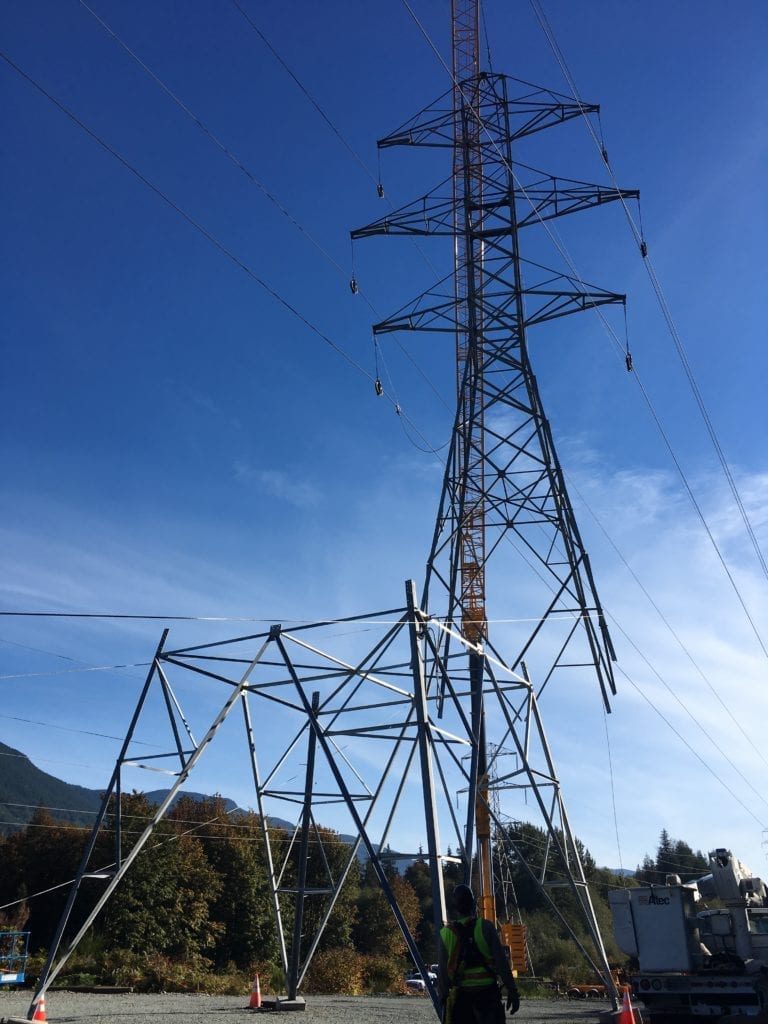
In December 2015, an emergency bank protection project at Boulder River, just east of Oso, Washington, revealed a need to relocate two of Seattle City Light’s lattice transmission towers. Natural river channel migration to the west caused erosion that threatened the structural stability of the towers. Several staff members at City Light worked together to build a two-phase improvement plan as a solution to this problem.
Seattle City Light’s Vegetation Management, Civil Construction, and North Overhead Line crews teamed up with Skagit crews to move the transmission towers further westward. Instead of rebuilding or constructing new towers the existing ones were simply relocated—although the overall process was not simple and required extensive teamwork across the utility. The benefits of this approach included reduced outage time frames, reduced construction costs and reduced project risk.
In July and August of this year, City Light crews constructed access road improvements, a temporary crane pad, working areas around the towers, stormwater management features, and built new tower foundations. Construction aggregate from a similar nearby project was relocated and stockpiled to be reused at Boulder River. This saved City Light approximately $140,000 in labor, time and materials.
Once the improvements were completed, crews began the tower relocation process in September and October. A 550-ton Ness crane was transported to the Boulder River site from Kent, Washington by way of seven separate tractor-trailer loads. Several planned outages, lasting up to two weeks, were required for crews to operate safely. While the actual move of a tower only takes about twenty minutes, it takes a full day to mobilize and set up the crane, another day to deconstruct it, and several days for crews to safely detach and reattach powerlines to the towers with new insulators.
The tower relocation was successfully and safely completed in late October 2018, with no accidents or near misses. The new towers are located 380 feet west of the original locations. By relocating the towers outside of the channel migration zone, our crews have ensured the long-term reliability of the transmission lines.
The second phase of this project is tentatively planned for 2019. Most of the rock rip rap which is temporarily stabilizing the bank will be replaced with permanent structures including engineered log jams and native plant species. This will result in a more fish-friendly environment.
Once the project is complete, City Light will have accomplished two key objectives:
1) increased the long-term reliability of the transmission lines thanks to the dedication of our crews and;
2) improved habitat to a condition much better than what existed previously as a commitment to environmental stewardship.
Special thanks to the project team responsible for this work:
North Overhead Line: Skip Allen, Mike Gibbons, Carl Stoper, Matt Tauzin, Kyle Bohannon, Damion Mohr,
Ryan Weber, Brandon Melland, Jason Timothy, Thomas Sharp
Skagit Power Structure Mechanic: Joey Aldridge
Vegetation Management: David Mutchler, Steve Barnard, Dave Daniels, Tom Marion
Randal Martin, David Trantham
Civil Construction: Greg Carlson, Tim Sullivan, Sean Reid
Carpenter Shop: Dan Mckinnon, Lenny Grinde, John Dewitt
Steel Shop: Eric Colville, Dean Aliment, Tony Chinn, Curt Blazich, Justin Forrest, Jay Master, Shaina Cornelius,
Dave Chase, Jim Payne
Civil and Resident Engineer: Brandan Vavrek, P.E.
Structural Engineers: Eli Wilson, P.E. and Owen Kohashi, P.E.
Transmission Engineer: Jimmy Lin, P.E.
Project Manager: William Chin
Natural Resources and Permitting Lead: Scott Luchessa
